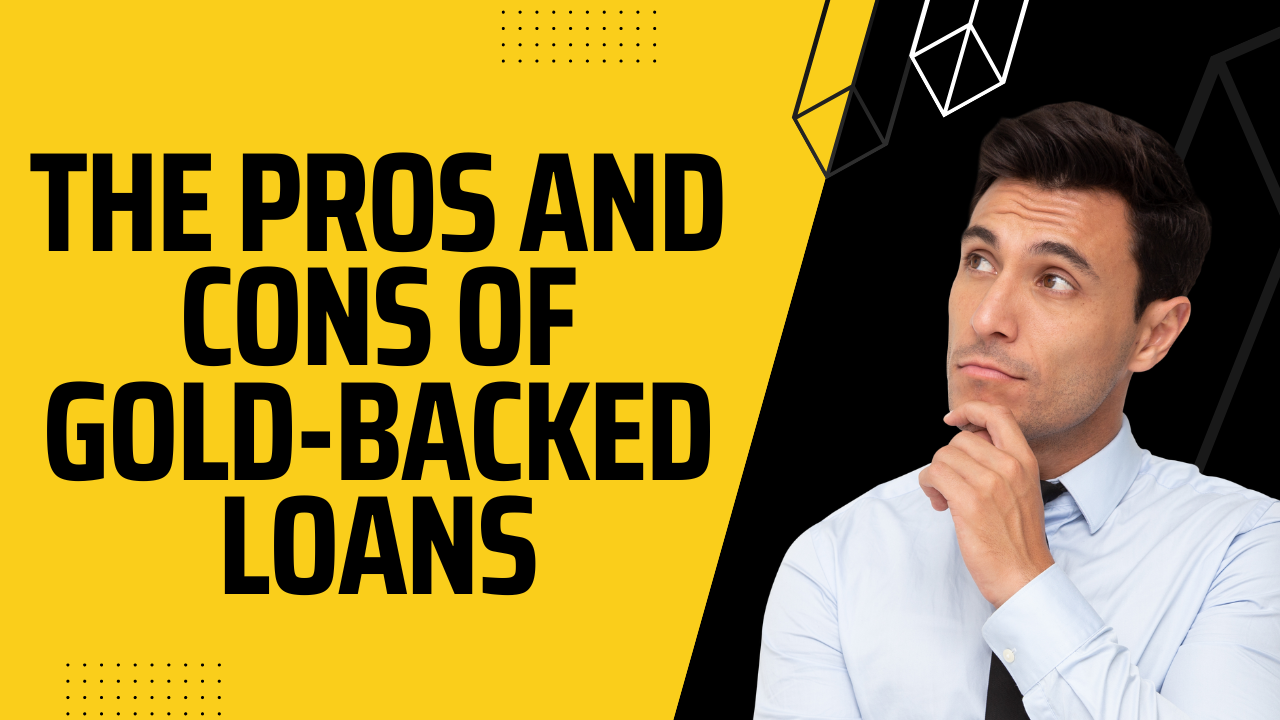In the arena of alternative financing, gold-backed loans have surfaced as a distinctive and valuable choice, allowing individuals to use their gold assets for immediate financial requirements. This guide delves into the intricate terrain of gold-backed loans, evaluating both the benefits and potential drawbacks. From the stability and accessibility provided by gold as collateral to the risks associated with market fluctuations and potential defaults, comprehending the pros and cons is essential for borrowers. Join us as we explore how gold-backed loans can serve as a dynamic financial instrument, shedding light on both the advantageous aspects and the potential pitfalls associated with unlocking the value of this precious metal for lending purposes.
The Glittering Advantage: Gold as Collateral
Gold, with its timeless allure, stands out as a coveted asset not only for its aesthetic appeal but also for the invaluable advantages it brings when used as collateral in loans.
Stability and Reliability:
One of the primary benefits of using gold as collateral is its inherent stability and reliability. Gold has proven to be a resilient asset over time, maintaining its value even in the face of economic uncertainties. This stability provides lenders with confidence, allowing borrowers to access funds with the assurance that their gold-backed loans are grounded in an asset with enduring value.
Accessibility and Quick Processing:
Gold-backed loans offer a streamlined and accessible borrowing experience. The liquidity and universal recognition of gold enable swift processing, making it an ideal option for individuals seeking immediate financial solutions. The simplicity of using gold as collateral eliminates lengthy approval processes, ensuring that borrowers can swiftly convert their gold assets into much-needed liquidity.
Lower Interest Rates:
Compared to some unsecured loans, gold-backed loans often come with lower interest rates. The secured nature of these loans, backed by the tangible value of gold, mitigates risk for lenders, resulting in more favorable terms for borrowers. This lower cost of borrowing is a significant advantage, making gold-backed loans an attractive option for those looking to access funds with minimized interest expenses.
Market Fluctuations and Default Concerns
While gold-backed loans offer undeniable advantages, it is crucial to navigate the potential risks associated with market fluctuations and the specter of default. Understanding the impact of market dynamics, evaluating default risks, and scrutinizing the Loan-to-Value Ratio (LTV) are essential components of informed decision-making in gold-backed borrowing.
Impact of Market Fluctuations:
Gold prices are subject to market fluctuations, and these can influence the overall dynamics of a gold-backed loan. The borrower should be cognizant of how changes in the market value of gold may impact the loan-to-value ratio and, consequently, the accessibility of funds. A proactive approach to monitoring market trends ensures that borrowers are well-prepared for potential adjustments in their loan terms.
Default Risks and Consequences:
Defaulting on a gold-backed loan can have serious consequences, including the loss of the pledged gold collateral. Borrowers need to be acutely aware of the terms and conditions related to default, emphasizing the importance of a realistic repayment plan. Transparent communication with lenders in case of financial challenges can open avenues for alternative solutions and mitigate the risk of default.
Evaluating Loan-to-Value Ratio (LTV):
The Loan-to-Value Ratio is a critical factor in gold-backed lending, representing the percentage of the appraised value of the gold that a lender is willing to advance. Understanding the LTV is imperative as it influences the amount of liquidity a borrower can access. Careful evaluation of this ratio helps borrowers align their expectations with the lender’s terms and navigate potential fluctuations in the value of their gold collateral.
Pros of Gold-Backed Loans
Gold-backed loans present a spectrum of advantages that make them an appealing financial option for a diverse range of borrowers.
Immediate Access to Liquidity:
One of the primary advantages of gold-backed loans is the swiftness with which borrowers can access liquidity. The inherent value and liquidity of gold facilitate a streamlined application process, allowing individuals to convert their gold assets into immediate cash. This rapid access to funds proves invaluable for addressing urgent financial needs, capitalizing on time-sensitive opportunities, or navigating unforeseen expenses with agility.
Minimal Impact on Credit Scores:
Unlike many unsecured loans, gold-backed loans typically have minimal impact on credit scores. Since these loans are secured by tangible assets (gold), lenders are often less concerned with the borrower’s credit history. This makes gold-backed loans an attractive option for individuals looking to secure financing without jeopardizing their credit standing. Responsible management of the loan, including timely repayments, can further enhance creditworthiness.
Strategic Use for Investments:
Gold-backed loans offer a strategic avenue for individuals to leverage their gold assets for investments. Whether venturing into the stock market, funding a business opportunity, or participating in a lucrative venture, the immediate liquidity provided by gold-backed loans empowers borrowers to seize investment prospects that align with their financial goals. This strategic use transforms gold from a static asset into a dynamic tool for wealth creation.
Cons of Gold-Backed Loans
While gold-backed loans bring forth undeniable advantages, it is equally crucial to acknowledge and navigate potential drawbacks associated with this form of financing.
Risk of Losing Pledged Assets:
One significant concern with gold-backed loans is the risk of losing the pledged gold assets in the event of default. If a borrower is unable to meet repayment obligations, the lender may seize the pledged gold collateral. This risk underscores the importance of careful financial planning and ensuring that the borrower’s repayment capacity aligns with the terms of the loan.
Potential for Higher Interest Rates:
Although gold-backed loans often feature lower interest rates compared to unsecured loans, there is still a potential for higher interest rates when compared to certain traditional secured loans. Lenders may factor in the perceived risks associated with gold’s market volatility, which can influence the overall cost of borrowing. Borrowers should carefully review and compare interest rates to ensure they align with their financial objectives.
Limited Loan Amounts:
The amount of funds a borrower can access through a gold-backed loan is limited by the appraised value of the pledged gold. This limitation may be a disadvantage for those seeking substantial financing. Individuals with high-value gold assets may find that the loan amount does not fully meet their financial needs, necessitating consideration of alternative financing options for larger requirements.
Precautions and Responsible Borrowing
Successfully navigating the landscape of gold-backed loans requires borrowers to adopt a proactive and responsible approach. Implementing precautions and adhering to responsible borrowing practices ensures a secure and favorable borrowing experience.
Transparent Communication with Lenders:
Open and transparent communication with lenders is paramount in the realm of gold-backed loans. If borrowers anticipate challenges in meeting repayment obligations, communicating this early with the lender allows for the exploration of alternative solutions. Lenders may be willing to work collaboratively to adjust repayment schedules. Or explore other options, fostering a cooperative and mutually beneficial relationship.
Understanding Terms and Conditions:
Thorough comprehension of the terms and conditions of a gold-backed loan is a fundamental precaution. Borrowers should scrutinize the loan agreement, paying close attention to interest rates, repayment terms, and potential fees. Clarity on these aspects ensures that borrowers make informed decisions and are not caught off guard by unexpected charges or conditions.
Crafting a Realistic Repayment Plan:
Responsible borrowing involves crafting a realistic repayment plan that aligns with the borrower’s financial capacity. Assessing income, expenses, and other financial obligations helps in determining a repayment schedule that is manageable and sustainable. A well-thought-out plan not only reduces the risk of default but also contributes to the borrower’s overall financial well-being.
Conclusion
In conclusion, the decision to engage in gold-backed loans involves a meticulous evaluation of the associated pros and cons. While these loans offer immediate liquidity, minimal credit score impact, and strategic investment possibilities. The risks of potential asset loss, higher interest rates, and limited loan amounts should not be overlooked. Borrowers must approach gold-backed loans with transparency, understanding the terms thoroughly, and crafting realistic repayment plans. By conscientiously weighing the advantages against the potential pitfalls. Individuals can make informed decisions, ensuring that gold-backed loans serve as a valuable financial tool aligned with their overall objectives and risk tolerance.
Also Read:
- Investment Taxation: Understanding Capital Gains, Dividends, and More
- The Impact Of Inflation On Investments
- What is the safest way to reduce investment risk?
- What are the major four assets of an investor portfolio?




